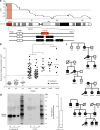Elevated basal serum tryptase identifies a multisystem disorder associated with increased TPSAB1 copy number
- PMID: 27749843
- PMCID: PMC5397297
- DOI: 10.1038/ng.3696
Elevated basal serum tryptase identifies a multisystem disorder associated with increased TPSAB1 copy number
Abstract
Elevated basal serum tryptase levels are present in 4-6% of the general population, but the cause and relevance of such increases are unknown. Previously, we described subjects with dominantly inherited elevated basal serum tryptase levels associated with multisystem complaints including cutaneous flushing and pruritus, dysautonomia, functional gastrointestinal symptoms, chronic pain, and connective tissue abnormalities, including joint hypermobility. Here we report the identification of germline duplications and triplications in the TPSAB1 gene encoding α-tryptase that segregate with inherited increases in basal serum tryptase levels in 35 families presenting with associated multisystem complaints. Individuals harboring alleles encoding three copies of α-tryptase had higher basal serum levels of tryptase and were more symptomatic than those with alleles encoding two copies, suggesting a gene-dose effect. Further, we found in two additional cohorts (172 individuals) that elevated basal serum tryptase levels were exclusively associated with duplication of α-tryptase-encoding sequence in TPSAB1, and affected individuals reported symptom complexes seen in our initial familial cohort. Thus, our findings link duplications in TPSAB1 with irritable bowel syndrome, cutaneous complaints, connective tissue abnormalities, and dysautonomia.
Figures


References
-
- Fellinger C, et al. Clinical characteristics and risk profile of patients with elevated baseline serum tryptase. Allergol Immunopathol (Madr) 2014;42:544–552. - PubMed
-
- Gonzalez-Quintela A, et al. Factors influencing serum total tryptase concentrations in a general adult population. Clin Chem Lab Med. 2010;48:701–706. - PubMed
-
- Henningsen P, Zimmermann T, Sattel H. Medically unexplained physical symptoms, anxiety, and depression: a meta-analytic review. Psychosom Med. 2003;65:528–533. - PubMed
Publication types
MeSH terms
Substances
Grants and funding
LinkOut - more resources
Full Text Sources
Other Literature Sources
Medical
Molecular Biology Databases

